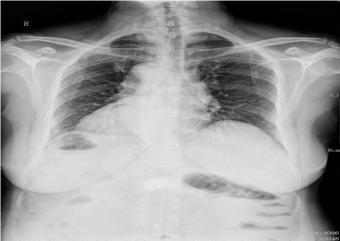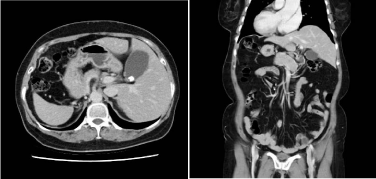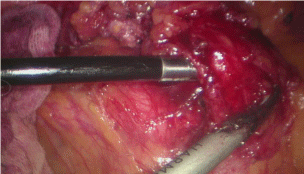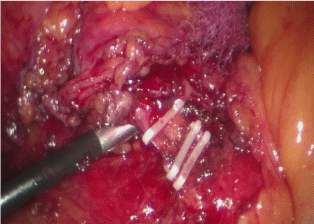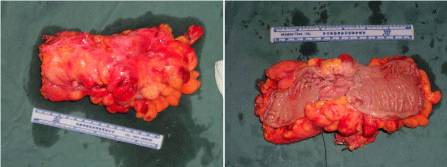Case Report
3D-Laparoscopic Total Mesorectal Excision in a Rectal Cancer Patient with Situs Inversus Totalis: A Case Report
Zhuang WH, Ping H, Zhao JH and Zhang X-Y*
Department of General Surgery, Huai’an People’s Hospital, Xuzhou Medical College, China
*Corresponding author: Xiao-Yu Zhang, Division of Gastrointestinal Surgery, Department of General Surgery, Huai’an People’s Hospital, Xuzhou Medical College, Huai'an, Jiangsu, China
Published: 11 Jul, 2016
Cite this article as: Zhuang WH, Ping H, Zhao JH, Zhang X-Y. 3D-Laparoscopic Total Mesorectal Excision in a Rectal Cancer Patient with Situs Inversus Totalis: A Case Report. Clin Surg. 2016; 1: 1070.
Abstract
Situs Inversus Totalis (SIT) is a rare anomaly in which the abdominal and thoracic cavity structures are located opposite to their usual positions. Occasionally, patients with this condition are
diagnosed with malignant tumors. We report a case of a 58-year-old woman with rectal cancer
and SIT. 3D-Laparoscopic Total Mesorectal Excision (TME) was performed successfully in a rectal
cancer patient by careful consideration of the mirror-image anatomy. The operation required 150
min, and no intraoperative complications occurred. The final pathology showed a 5.0cm2
× 4.5cm2 adenocarcinoma with whole layer invasion. Sixteen lymph nodes were examined, and 7 regional
lymph nodes metastasis (pT4aN2a, LN7/16), according to the American Joint Committee on
Cancer 7th edition staging guidelines. The postoperative course was uneventful, and the patient was
discharged on postoperative day 10. We believe that this is the first case of 3D-Laparoscopic TME
reported in a SIT patient with rectal cancer.
Keywords: Situs inversus totalis; 3D-laparoscopic; Total mesorectal excision; Rectal cancer
Introduction
Situs Inversus Totalis (SIT) is a rare autosomal recessive congenital anomaly, occurring at an incidence of one in every 5,000 to 20,000 people. It is characterized by the transposition of the abdominal and/or thoracic organs, but it does not affect health or life expectancy. It is detected accidentally during a radiological examination. Laparoscopic Total Mesorectal Excision (TME) in SIT patients with rectal cancer was first reported in 2010 [1]. However, to the best of our knowledge, there has been no report of 3D-laparoscope surgery for rectal cancer in SIT patients. We here report a case of 3D-laparoscopic TME for rectal cancer in a patient with SIT.
Case Presentation
A 58-year-old woman was admitted to our gastroenterology ward on March 14, 2016, with
bloody stool for 6 months. Colonoscopy revealed an ulcerative tumor in the upper rectum, 16 cm
from the anal verge; biopsy confirmed that it was a poorly differentiated adenocarcinoma. She was
a married woman. She was 155 cm tall and weighed 60.5 kg. Regarding the laboratory findings,
she had no anemia (red blood cell count, 4.49 × 1012 L; hemoglobin, 139 g/L; hematocrit, 42%) and
no hepatic, renal, or electrolyte dysfunction. The serum carcinoembryonic antigen was elevated
(25.10 ng/mL; reference value, < 5ng/mL). The serum carbohydrate chain antigen199 (CA199)
was elevated (35.50 ng/mL; reference value, < 35ng/mL). Chest radiography showed dextrocardia
and a right subphrenic gastric bubble (Figure 1). Abdominopelvic computed tomography showed
complete transposition of the abdominal viscera, confirming situs inversus total is (Figure 2).
In March 22, 2016, a 3D-laparoscopic anterior resection with a radical lymphadenectomy was
performed. After general anesthesia was induced, the patient was placed in a lithotomy position.
The surgeon stood on the left side of the patient (opposite the usual side for surgery at our hospital).
A 10-mm supraumbilical port was placed, and a 3D- telescope was introduced into the peritoneal
cavity. Additional trocars included a 12-mm trocar in the left flank and a 5-mm trocar in the left iliac
fossa as working ports for the operator, and a 12-mm trocar in the right iliac fossa and 5-mm trocar
in the right flank for traction.
The laparoscopic view showed that the sigmoid colon was observed on the right side, along
with the spleen. The liver was in the left upper quadrant. The sigmoid colon was mobilized using
ultrasonic dissection. The right ureter was clearly identified and was avoided during dissection
(Figure 3). The inferior mesenteric artery was isolated and divided at its origin (Figure 4). And then the operator and endoscopist positioned themselves on the right with the first assistant on the left to
mobilize the rectum and make the anastomosis, because the operator
was right-handed. The TME was performed, and the distal rectum
was divided using articulating endoscopic linear stapler. Using an
extension (about 5 cm) to a trocar site in the right iliac fossa, the
specimen was extracted and amputated. A purse string suture was
used to hold the anvil of a circular stapling device in the proximal
colon. The colon was returned to the abdomen, and the abdominal
incision was closed. After restoring the pneumoperitoneum, a 29-mm
end-to-end anastomotic stapling device was inserted anally, and the
anastomosis was completed.
The operating time was 150 min, and the blood loss was 50
mL. Macroscopically, the tumor was a 5.0cm2
× 4.5cm2 ulcerated
lesions in the rectum (Figure 5). Histological examination of the
resected specimen disclosed adenocarcinoma with whole layer
invasion. Sixteen lymph nodes were examined, and 7 regional lymph
nodes metastasis (pT4aN2a, LN7/16), according to the American
Joint Committee on Cancer 7th edition staging guidelines. The
postoperative course was favorable, and the patient was discharged
on postoperative day 10.
Figure 1
Figure 2
Figure 2
Computed tomography disclosing complete transposition of the abdominal viscera (A) coronal view and (B) axial view.
Figure 3
Figure 3
Origin of the Inferior Mesenteric Artery (IMA) from the right side of the abdominal aorta. CIA, common iliac artery
Figure 4
Figure 5
Discussion
Three-dimensional (3D) High-Definition (HD) laparoscopy
has brought a new direction for minimally invasive surgery, which
has been gradually applied to laparoscopic hernia repair surgery,
colorectal surgery, hysterectomy, urology, cardiothoracic surgery
and so on [2]. Depending on the 3D laparoscopy, stereo image can
be associated with augmented reality and offers the advantage of
improved depth perception and accuracy [3].
Situs Inversus Totalis (SIT) is a rare anomaly in which the
abdominal and thoracic cavity structures are located opposite to
their usual positions. The etiology of SIT remains obscure, and
this condition does not influence normal health or life expectancy;
however, it has important surgical implications. Laparoscopic
surgeries in SIT patients have documented greater technical
difficulties due to the altered anastomotic orientation [4-8].
Recently, a successful laparoscopic surgery for rectal cancer in
a SIT patient has been reported [1]. A 41-year-old woman with SIT
who developed rectal cancer was successfully treated by laparoscopic
Total Mesorectal Excision (TME). The surgeon had performed more
than 500 laparoscopic colectomies at the time. This case suggests
that laparoscopic TME is an alternative technique for the treatment
of malignancies in patients with SIT. However, many anatomical
variations are possible in the procedure, which can complicate this
goal. The lack of depth perception and spatial orientation when
using traditional 2D imaging is a recognized limitation of minimally
invasive surgery in comparison with open surgery. Conversely,
3D vision offers the advantage of improved depth perception and
accuracy comparable to open surgeries. As a minimally invasive
surgical technique, 3D laparoscopic surgery facilitates more precise
and easier operation compared with 2D laparoscopy.
The present patient is the first rectal cancer with SIT to undergo
3D-laparoscopic TME. Our case is also likely the first case in China.
Because the depth perception provided by the 3D imaging system,
aided visualization of critical vascular relationships and multiple
tissue layers, such as ureter, seminal vesicle, female posterior vaginal
wall, the operation was completed in 150 minutes with 50 mL of
bleeding.
3D-laparoscopic Total Mesorectal Excision (TME) in rectal cancer
patient can provide better sense of depth to facilitate precise operation
and, in turn, shorten the operation time. Thus, 3D-laparoscopic
systems should improve minimally invasive surgery, and enable more
complex resections to be performed in the future.
A large series of 3D-laparoscopic radical resection for rectal
cancer have recently been reported. The reports demonstrated
that 3D-laparoscopic surgery for rectal cancer is a safe and feasible
alternative procedure in laparoscopic surgery. As exemplified by our
patient, 3D-laparoscopic surgery can be successfully used to treat
rectal cancer in SIT patients.
References
- Huh JW, Kim RH, Cho HS, Kim YC, Kim JH, Joo KJ, et al. Laparoscopic Total Mesorectal Excision in a Rectal Cancer Patient with Situs Inversus Totalis. J Korean Med Sci. 2010; 25: 790-793.
- McLachlan G. From 2D to 3D: the future of surgery? Lancet. 2011; 378: 1368
- Yang C, Mo L, Ma Y, Peng G, Ren Y, Wang W, et al. A comparative analysis of lung cancer patients treated with lobectomy via three-dimensional video-assisted thoracoscopic surgery versus two-dimensional resection. J Thorac Dis. 2015; 7: 1798-1805.
- Seo KW, Yoon KY. Laparoscopy-assisted distal gastrectomy for early gastric cancer and laparoscopic cholecystectomy for gallstone with situs inversus totalis: a case report. J Korean Surg Soc. 2011; 8: S34-38.
- Borude S, Jadhav S, Shaikh T, Nath SR. Laparoscopic sleeve gastrectomy in partial situs inversus. J Surg Case Rep. 2012; 2012: 8.
- Min SH, Lee CM, Jung HJ, Lee KG, Suh YS, Shin CI, et al. Laparoscopic distal gastrectomy in a patient with situs inversus totalis: a case report. J Gastric Cancer. 2013; 13: 266-272.
- Fang FJ, Zheng HZ, Wei B, Chen FT, Lei RP, Huang LJ, et al. Laparoscopic resection for rectal cancer and cholecystectomy for patient with situs inversus totalis. 2015; 11: 210-212.
- Morimoto M, Hayakawa T, Kitagami H, Tanaka M, Matsuo Y, Takeyama H. Laparoscopic-assisted total gastrectomy for early gastric cancer with situs inversus totalis: report of a first case. BMC Surg. 2015; 19: 15.

